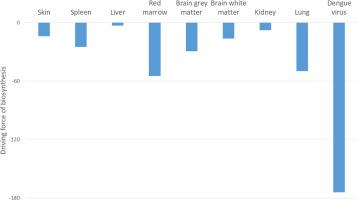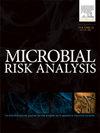Biothermodynamic analysis of the Dengue virus: Empirical formulas, biosynthesis reactions and thermodynamic properties of antigen-receptor binding and biosynthesis
IF 3
4区 环境科学与生态学
Q2 ENVIRONMENTAL SCIENCES
引用次数: 0
Abstract
After the experience with the COVID-19 pandemic, WHO has issued a warning about the possible causes of future pandemics. One such causative agent is the Dengue virus. Until now, we have had information mostly on biological properties of the Dengue virus and very little information about its chemical and thermodynamic properties. To be better prepared for a potential Dengue pandemic, the goal of this paper is to chemically and thermodynamically characterize the Dengue virus, as well as to describe the biophysical basis of the virus-host interactions of the Dengue virus. To that goal, the empirical formula was determined, as well as biosynthesis reactions and thermodynamic properties of antigen-receptor binding and thermodynamic properties of biosynthesis and multiplication of the Dengue virus. A model was developed of virus-host interactions between the Dengue virus and its host tissues, based on nonequilibrium thermodynamics.

登革热病毒的生物热力学分析:抗原受体结合和生物合成的经验公式、生物合成反应和热力学特性
在经历了 COVID-19 大流行之后,世卫组织就未来大流行的可能原因发出了警告。登革热病毒就是其中一种致病因子。到目前为止,我们所掌握的信息主要是登革热病毒的生物特性,而有关其化学和热力学特性的信息却非常少。为了更好地应对可能出现的登革热大流行,本文旨在从化学和热力学角度描述登革热病毒的特性,以及登革热病毒与宿主相互作用的生物物理基础。为此,确定了登革热病毒的经验公式、生物合成反应、抗原-受体结合的热力学性质以及生物合成和繁殖的热力学性质。根据非平衡热力学,建立了登革热病毒与其宿主组织之间的病毒-宿主相互作用模型。
本文章由计算机程序翻译,如有差异,请以英文原文为准。
求助全文
约1分钟内获得全文
求助全文
来源期刊

Microbial Risk Analysis
Medicine-Microbiology (medical)
CiteScore
5.70
自引率
7.10%
发文量
28
审稿时长
52 days
期刊介绍:
The journal Microbial Risk Analysis accepts articles dealing with the study of risk analysis applied to microbial hazards. Manuscripts should at least cover any of the components of risk assessment (risk characterization, exposure assessment, etc.), risk management and/or risk communication in any microbiology field (clinical, environmental, food, veterinary, etc.). This journal also accepts article dealing with predictive microbiology, quantitative microbial ecology, mathematical modeling, risk studies applied to microbial ecology, quantitative microbiology for epidemiological studies, statistical methods applied to microbiology, and laws and regulatory policies aimed at lessening the risk of microbial hazards. Work focusing on risk studies of viruses, parasites, microbial toxins, antimicrobial resistant organisms, genetically modified organisms (GMOs), and recombinant DNA products are also acceptable.
 求助内容:
求助内容: 应助结果提醒方式:
应助结果提醒方式:


